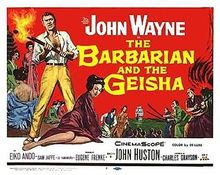The Barbarian and the Geisha
 Theatrical release poster | ||
| Starring | John Wayne | |
| Directed by | John Huston | |
| Produced by | Eugene Frenke | |
| Editing by | Stuart Gilmore | |
| Studio | 20th Century Fox | |
| Narrated by | Eiko Ando | |
| Music by | Hugo W. Friedhofer | |
| Cinematography | Charles G. Clarke | |
| Distributed by | 20th Century Fox | |
| Released | 09} 30, 1958 | |
| Runtime | 105 minutes | |
| Country | United States | |
| language | English | |
| Budget | $3,495,000 | |
The Barbarian and the Geisha (working titles The Townsend Harris Story and The Barbarian) is a 1958 American adventure drama film directed by John Huston and starring John Wayne. The film was shot primarily on location in Japan.
Townsend Harris is appointed the first Consul General to Japan. Upon his arrival, Harris discovers that the Japanese thoroughly mistrust all foreigners, despite a two-year-old treaty between Japan and the United States. Harris slowly earns the respect of the local governor and trust of the local townsfolk and is eventually granted an audience with Japan's military dictator, the Shōgun.
Plot
In 1856, Townsend Harris (John Wayne) is sent by President Franklin Pierce to serve as the first U.S. Consul General to Japan, following the treaty written by Commodore Matthew Perry two years before. Accompanied only by his translator-secretary, Huesken (Jaffe) and three Chinese servants, Townsend comes ashore at the town of Shimoda prefecture, as specified in the treaty as the location for an American consulate.
However, the Japanese governor (Sō Yamamura) refuses to accept his credentials, denying him any official status, due to a conflict between interpretations of the treaty terms. While Harris believes that the Consul shall be present whenever either country requires it, the Japanese believe the terms permit a consul only when both countries require it. The governor holds to his interpretation, largely because of objections over the threats under which the treaty was forced upon them. Harris is permitted to remain in Shimoda, but only as a private citizen, with no recognition of his official status. He is provided the use of an abandoned home adjacent to the town cemetery.
The governor explains that in the two years following Perry's visit, various natural disasters had taken place. Some Japanese believed them to be warnings from the gods to avoid foreign influences. In the weeks that follow, Harris is the target of distrust and hostility, to the extent that Tamura orders townspeople not even to sell him food. Some in Japan wanted the country opened, but many others feared the corruption of foreign influences and invasion by the barbarians of other lands. For this reason, Harris is not permitted to leave Shimoda nor to go any closer to the capitol in Edo, 100 miles away.
For his own part, Harris does his best to cooperate with the Governor, even obeying orders to take down the American flag, which had been raised to mark the location of the Consulate. His cooperation noted, after several months, Harris is eventually invited to dine with the Governor, a dinner following which Tamura sends a geisha named Okichi (Eiko Ando) to take care of Harris' needs.
The relationship between Harris and Okichi grows closer and more intimate, and she helps him understand Japanese culture.
Harris helps rid the village of a cholera epidemic, and out of this comes Harris' opportunity to go to Edo, where he must then convince the Shogunate to open the country while facing his greatest crisis.
Historical background
The film is based on American diplomat Townsend Harris and his time in Japan during the final years of the Tokugawa shogunate. President Franklin Pierce named Harris the first Consul General to the Empire of Japan in July 1856. He opened the first U.S. Consulate at the Gyokusen-ji Temple in the city of Shimoda, Shizuoka Prefecture. This consolidated the mission by Commodore Perry, who established the first trade agreement between the U.S. and Japan in 1853. Harris left Japan in 1861.
In Harris' time, Japan was living through the final years of its period when the country remained in international isolation and adhered to strict customs and regulations intended to promote stability. In 1868, just seven years after Harris' departure, the Meiji Restoration started Japan's emergence as a modernized nation in the early twentieth century through massive industrialization and enormous reforms to its political and social structure.
The film incorporates the enduring Japanese legend about Harris and a 17-year-old geisha named Okichi (お吉). The story says she was pressured by Japanese authorities into forming a relationship with Harris in order to make the trade meetings go more smoothly. However, after Harris departed Japan to return to America, she was insultingly called the "Barbarian Okichi" and was ostracized by her people; as a result, she began drinking and eventually committed suicide in 1892. According to historians, however, most of the story is simply untrue. Although Okichi was a real person, she was merely one of Harris' housekeepers, and he apparently fired her after only three days of working for him.
External links
- Review The Barbarian and the Geisha at the Internet Movie Database
- The Barbarian and the Geisha at All Movie Guide
- Review The Barbarian and the Geisha at the Turner Classic Movie Database
Chat rooms • What links here • Copyright info • Contact information • Category:Root